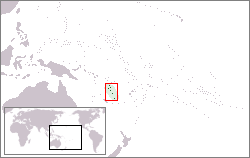New Hebrides Islands
| New Hebrides Condominium | ||||||||||
| Condominium des Nouvelles-Hébrides | ||||||||||
|
||||||||||
|
New Hebrides
|
||||||||||
| Capital | Port Vila | |||||||||
| Languages | English, French, Bislama | |||||||||
| Political structure | Special territory | |||||||||
| History | ||||||||||
| • | Established | 1906 | ||||||||
| • | Independence | 30 July 1980 | ||||||||
| Area | ||||||||||
| • | 1976 | 12,189 km² (4,706 sq mi) | ||||||||
| Population | ||||||||||
| • | 1976 est. | 100,000 | ||||||||
| Density | 8.2 /km² (21.2 /sq mi) | |||||||||
| Currency | New Hebrides franc | |||||||||
|
||||||||||
New Hebrides, named for the Hebrides Scottish archipelago, was the colonial name for the island group in the South Pacific Ocean that now is the nation of Vanuatu. Native people had inhabited the islands for three thousand years before the first Europeans arrived in 1606 from a Spanish expedition led by Pedro Fernandes de Queirós. The islands were colonized by both the British and French in the 18th century, shortly after Captain James Cook visited the islands.
The two countries eventually signed an agreement making the islands an Anglo-French condominium, which divided the New Hebrides into two separate communities: one Anglophone and one Francophone. This divide continues even after independence, with schools teaching in either one language or the other, and with different political parties. The condominium lasted from 1906 until 1980, when the New Hebrides gained their independence as Vanuatu.
The New Hebrides was a rare form of colonial territory in which sovereignty was shared by two powers, Britain and France, instead of just one. Under the Condominium there were three separate governments – one French, one British, and one joint administration that was partially elected after 1975.
The French and British governments were called residencies, each headed by a resident appointed by the metropolitan government. The residency structure greatly emphasized dualism, with both consisting of an equal number of French and British representatives, bureaucrats and administrators. Every member of one residency always had an exact mirror opposite number on the other side who they could consult. The symmetry between the two residencies was almost exact.
...
Wikipedia


